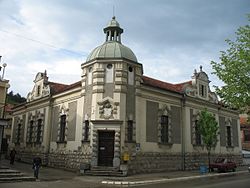Prokuplje
|
Prokuplje Прокупље |
||||
|---|---|---|---|---|
| Town and municipality | ||||
From top: Town panorama, National Museum
|
||||
|
||||
 Location of the municipality of Prokuplje within Serbia |
||||
| Coordinates: 43°14′N 21°36′E / 43.233°N 21.600°ECoordinates: 43°14′N 21°36′E / 43.233°N 21.600°E | ||||
| Country |
|
|||
| Region | Southern and Eastern Serbia | |||
| District | Toplica | |||
| Settlements | 107 | |||
| Government | ||||
| • Mayor | Miroljub Paunović (SNS) | |||
| Area | ||||
| • Municipality | 759 km2 (293 sq mi) | |||
| Elevation | 273 m (896 ft) | |||
| Population (2011 census) | ||||
| • Town | 27,333 | |||
| • Municipality | 44,419 | |||
| Time zone | CET (UTC+1) | |||
| • Summer (DST) | CEST (UTC+2) | |||
| Postal code | 18400 | |||
| Area code | +381 27 | |||
| Car plates | PK | |||
| Website | www |
|||
Prokuplje (Serbian Cyrillic: Прокупље, Serbian pronunciation: [prǒkupʎe]) is a town, municipality and the administrative center of the Toplica District in the southern Serbia. According to 2011 census, the town has a total population of 27,333 inhabitants, while population of municipality is 44,419. It is one of the Roman sites of Serbia. It was a kaza center in Niš sanjak as "Ürgüp" during Ottoman rule and was incorporated in Kingdom of Serbia in 1878.
The Prokuplje municipality is located between municipalities of Blace, Kuršumlija, Bojnik, Žitorađa, Merošina, Aleksinac, and Kruševac.
The traces of early settlements can be found on neolithic localities such as Macina (near Zitni Potok), Kavolak 6 kilometres (4 miles) west of Prokuplje (village Donja Trnava) and settlements on the south slopes of Jastrebac in Donja Bresnica village. The Vinca period is preserved in the Plocnik locality (22 km [14 mi] from Prokuplje), on the left side of the road from Prokuplje to Kursumlija. The earliest known metalworking in the world was found in Pločnik in 2007 dating to 5500 BC making the Copper Age several centuries older than previously thought. Those agricultural settlements were replaced by the emerging Thracians and then the invading Celtic Scordisci in 279 BC. Pieces of ceramics found by the Latin church are traces of those tribes movement on their way to Greece.
...
Wikipedia



